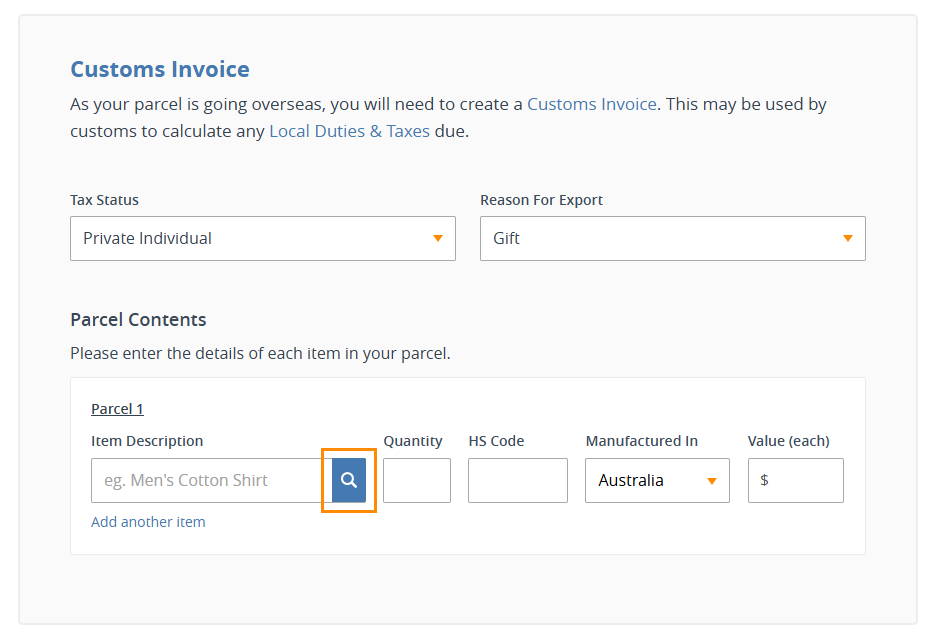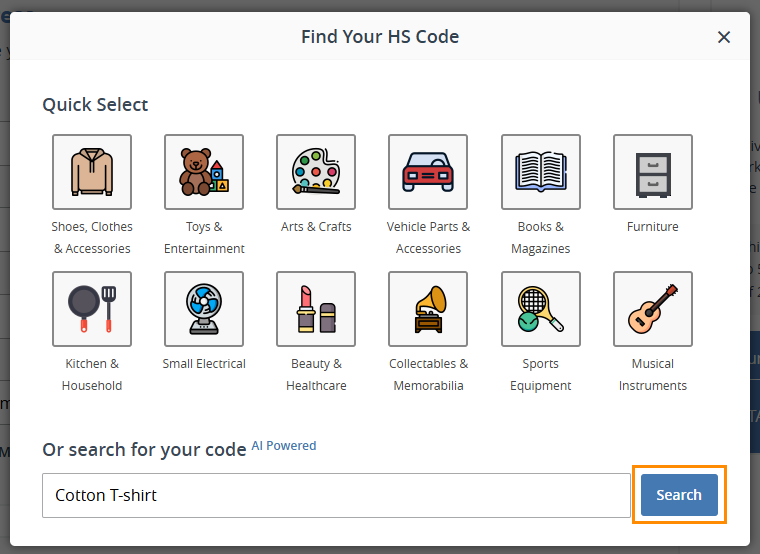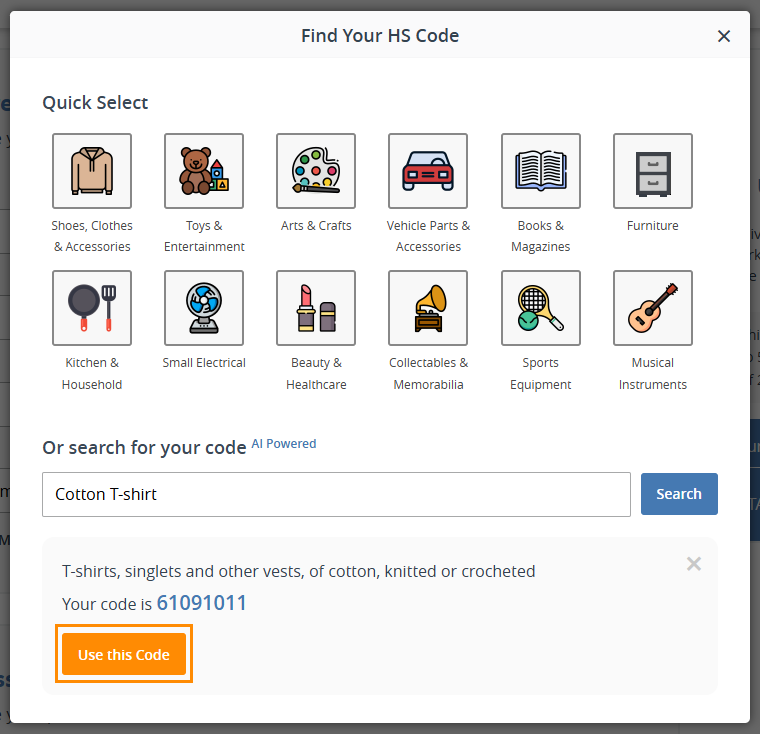Adding HS Codes
When shipping goods internationally, whether you’re based in Australia, selling to the European Union, or anywhere else, understanding and using the correct Harmonised System (HS) codes is crucial. HS codes are standardised numerical classifications for products, enabling customs authorities and logistics providers worldwide to identify the nature of the goods, determine applicable duties, and ensure compliance with international trade regulations.
Use the links below to jump to the section you need and get step-by-step guidance on understanding and applying HS codes for international shipping.
- What’s a HS Code?
- Who Needs a HS Code?
- How HS Codes Work with Your E-Commerce Platform
- How to Find the HS Code
- Additional Details and Considerations
What’s a HS Code?
An HS (Harmonised System) code is a globally recognised numeric classification for traded products, typically consisting of six to ten digits. Each code describes a specific category of goods, from clothing and electronics to automotive parts and homewares. By using the right HS code, you provide customs authorities with a universal “language” that clearly communicates what you’re shipping:
Key Benefits:
- Global Standardisation: HS codes are used by more than 200 countries, streamlining international trade.
- Accurate Duty and Tax Calculation: With the correct HS code, customs can determine the right tariffs, taxes, and VAT rates for your shipment.
Who Needs a HS Code?
Anyone sending goods across international borders needs to assign an HS code, this includes both businesses and individuals. Whether you're shipping a single item or running a full-scale ecommerce operation, HS codes are essential for customs clearance and compliance.
- Online Sellers: If you sell products internationally through your own website or a marketplace.
- Manufacturers and Wholesalers: Bulk shipments require accurate HS codes to calculate duties and ensure compliance.
- Importers and Exporters: Any business involved in global trade, regardless of size.
- Individuals: Even if you’re just sending a gift or personal item overseas, you still need to use the correct HS code to avoid delays or unexpected charges.
How HS Codes Work with Your E-Commerce Platform
Your ecommerce platform might not automatically assign HS codes, but they’re essential when shipping internationally. HS codes (Harmonised System codes) are used when you:
- Create shipping labels
- Fill out customs forms
- Upload product data to international marketplaces
When you book an international shipment, you’ll usually be asked to provide the HS code. Interparcel uses this information to automatically generate the necessary customs documents. This helps your parcels clear international borders without delays and ensures the correct duties and taxes are applied upfront.
If you’ve included HS codes in your product descriptions within your Shopify or WooCommerce store, they’ll automatically import into the inventory section of the Interparcel platform when syncing your products. This makes it easier to manage HS codes for all your SKUs and streamline international fulfilment.
If an HS code hasn’t been included during import or you're using another ecommerce platform, you can also manually enter it directly in the Interparcel inventory.
How to Find the Right HS Code
Whether you use the Shipping Calculator or the Shipping Manager on our platform, you’ll be asked to complete the Customs Invoice section. You’ll need to provide:
- Your Tax Status
- Reason for Export
- Required identification numbers (varies by destination country)
- For each product:
- A clear, specific product description: what is it and what's made of?
- Quantity
- HS Code (10-digit code for U.S. , check here)
- Country of Manufacture
- Value (of each item)
When booking international shipments through our platform, you can automatically generate the HS Code simply by entering a detailed description of your product. Our system uses AI to suggest the most accurate code based on your input, saving you time and reducing the risk of manual errors.
That said, it's always a good idea to double-check the HS Code is correct for each country you're shipping to. While the first six digits are usually standard worldwide, countries can add up to four extra digits to classify products further, and these can differ by destination.
You can verify your HS Code using the official tools for each region:
- NZ Tariff Finder
- UK Integrated Online Tariff Look Up
- U.S. Schedule B Search Engine , watch this video to learn more about U.S. HS Codes.
These sites ensure your code matches local customs requirements and help prevent clearance issues or unexpected charges.
Follow these steps to select the HS Code on our platform:
- In the Customs Invoice section, click the Search button next to Item Description.
- Enter the item name and what it’s made of and click Search.
- A list of matching HS codes and descriptions will appear. Click Use this Code to automatically fill in the HS code. If you're shipping to the US, please note that you’ll need to enter a 10-digit HS Code, which you can find here.
- After checkout, your commercial invoice will be generated using this information. You’ll need to print three copies and attach them to your parcel, along with any other required documents such as your shipping label.



Additional Details and Considerations
Global Standardisation:
HS codes ensure that no matter where your package is headed, EU, North America, Asia, or beyond, customs officials have a clear understanding of what’s inside. This universal approach reduces misunderstandings and speeds up processing.
Determining Duties and Taxes:
Accurate HS codes mean accurate duty calculations. If you pick the wrong code, you risk overpaying on taxes or facing disputes at customs, potentially causing delays and extra costs.
Ensuring Compliance and Smooth Customs Clearance:
Correct HS codes are a key compliance factor. Customs officials rely on them to apply appropriate regulations, safety checks, and import controls. Getting it right minimises the chance of your shipment being held, inspected, or returned.
Keep in mind that customs authorities may open your parcel to verify its contents. If the description or HS code on your commercial invoice doesn’t match what’s inside, your shipment could be delayed, fined, or rejected. Double-checking your information helps avoid these risks.
Updating Codes for Accuracy:
Products evolve, and so do classification rules. Make sure to periodically review the HS codes for your products, especially if you modify materials, packaging, or product lines. Staying up to date helps maintain smooth operations and avoid penalties.
In Summary:
HS codes form the backbone of international trade classification. By assigning the correct code to each product, you help customs authorities understand what you’re shipping, calculate the right duties and taxes, and let your parcels move swiftly across borders. This careful attention to detail ensures a more predictable, cost-effective, and compliant global shipping experience.
Other Relevant Guides
- Send Your Orders Via our Shipping Manager
- Shopify Integration
- Connect your MyPost Business Account with Interparcel
